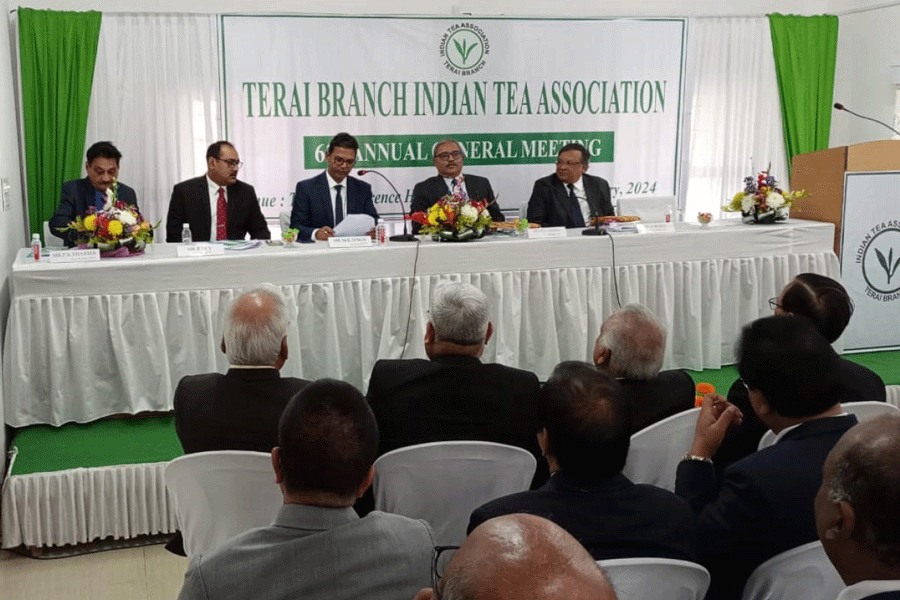
Siliguri: Largest association of planters in India flag hurdles to tea sector’s growth
Don't Miss
Indian Tea Association’s representatives congregate at 62nd annual general meeting of its Terai branch in Bengdubi
 |
| Representatives of the Indian Tea Association at the 62nd annual general meeting of the ITA’s Terai branch in Siliguri on Friday.: Passang Yolmo |
Avijit Sinha, TT, Siliguri, 20.01.24 : The largest association of tea planters in India has flagged a number of issues like the import of tea from Nepal and the rise in the cost of production which are acting as stumbling blocks to the industry.
The Indian Tea Association’s representatives congregated at the 62nd annual general meeting of its Terai branch in Bengdubi, on the outskirts of Siliguri, on Friday, and elaborated on issues which were affecting the sector
Darjeeling Tea
The production of Darjeeling Tea, which is still considered the best brew in the world for its unique muscatel, has declined. A number of gardens are lying close in the hills and tea companies having gardens in the hills are struggling for sustainability.
“The holdings are small, unlike the gardens in the Dooars and the Terai. Also, the yield is low. On the other hand, they had to bear expenses at the same rate as other gardens, right from wage rate to power tariff. That is why a number of gardens are finding it difficult to reach the break-even point. We have asked for a comprehensive package from the Centre for the Darjeeling Tea industry,” said Arijit Raha, secretary general, ITA.
Import from Nepal
The import of Nepal tea is yet another factor that has been highlighted by stakeholders of the industry a number of times in recent years.
“According to the data, around 13 million kilos of tea were imported last year, most of which came from Nepal. We are aware that the same tea is being sold here as well as exported outside. We have mentioned that such tea should comply with the standards of FSSAI (Food Safety & Standards Authority of India) to ensure that teas imported here are of standard quality,” said Atul Asthana, chairman, ITA.
Although the import from Nepal appears to be minuscule as India produces over 1,300 million kilos of tea in a year, it is affecting the market of Darjeeling tea as it is grown in similar weather conditions.
“It is not CTC tea but orthodox leaf tea like Darjeeling which comes from Nepal. This is a new poser for Darjeeling tea,” said a Siliguri-based planter.
Asthana mentioned that in their submissions to the tea board and the Union commerce ministry, they pointed out that there should be a minimum import price. “We have mentioned that teas which are below our cost of production should not be imported and sold as it would affect our market,” he said.
Cost of production
The ITA also mentioned that in the past three years, there has been a rise of 42 per cent in tea wages in Bengal, given the back-to-back revisions done by the state government because the minimum wage has not yet been fixed.
In the past 10 years, the CAGR (compounded annual growth rate) of tea prices is 4.5 per cent, which is lower than inflation while the cost of inputs has increased by 10 to 12 per cent.
“In organized tea sector (tea estates), around 70 per cent of the overhead costs are fixed and cannot be reduced. There has been a steady rise in cost of production but the prices in auctions have almost remained stagnant. Added to it is the demand-supply mismatch. That is why, we need to reduce the supply for better price realization,” said Raha.
Silver lining
The industry is looking forward to the initiatives of the state and the central governments. The state, they said, is providing houses and extending various welfare schemes to tea workers and their families.
“It is beneficial for the industry as we have to provide certain benefits under the Plantation Labour Act. In the coming days, the tea industry needs such support for its sustenance,” said Raha.
Asthana, the ITA chairman, said they have sought subsidies on the production of orthodox teas and financial assistance in some other forms for the tea gardens.
“The tea tourism policy which has been introduced by the state government is also helping tea gardens to explore alternative earning options as well as create some employment at the local level,” said Asthana.


0 Response to " Siliguri: Largest association of planters in India flag hurdles to tea sector’s growth"
Post a Comment
Disclaimer Note:
The views expressed in the articles published here are solely those of the author and do not necessarily reflect the official policy, position, or perspective of Kalimpong News or KalimNews. Kalimpong News and KalimNews disclaim all liability for the published or posted articles, news, and information and assume no responsibility for the accuracy or validity of the content.
Kalimpong News is a non-profit online news platform managed by KalimNews and operated under the Kalimpong Press Club.
Comment Policy:
We encourage respectful and constructive discussions. Please ensure decency while commenting and register with your email ID to participate.
Note: only a member of this blog may post a comment.